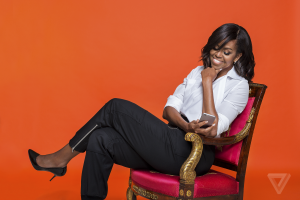 The December issue of Vogue magazine features a candid conversation with Michelle Obama as she prepares for life outside the White House. In her time as “America’s Champion and Mother in Chief”, the First Lady achieved a lot including supporting military families, promoting healthy eating with the White House garden, and developing a mentoring program for disadvantaged girls.
The December issue of Vogue magazine features a candid conversation with Michelle Obama as she prepares for life outside the White House. In her time as “America’s Champion and Mother in Chief”, the First Lady achieved a lot including supporting military families, promoting healthy eating with the White House garden, and developing a mentoring program for disadvantaged girls.
Most probably though, she will be remembered for her fashion choices—sleeveless dresses, bold colours and patterns, boosting young designers, and wearing moderately priced designer clothing. But when asked how she decides what to wear, she said, “It all boils down to comfort level: If I’m going to make you comfortable, then I have to be comfortable first.”
This is so true. It doesn’t matter who you are or what you do, if your clothing isn’t comfortable, then you’re not comfortable. And it shows. Your clothing is a powerful non-verbal communications tool. If what you’re wearing is comfortable, you’ll be confident and communicate that confidence with style. I call it the three C’s—comfort, confidence, communication.
So how to you make sure your clothing is comfortable?
- Fit—Clothing that fits just skims the body with no outline of what’s beneath. That means shoulders that sit on your natural shoulders, no straining seams, buttons ready to pop, pant hems dragging on the floor or extra fabric that makes you look frumpy. A little bit of tailoring can make all the difference.
- Fabric—Does wool make you itch? Synthetics make you sweat? Is the fabric too stiff to move? Check labels on clothing and remember the fabric contents. Natural fabrics are hard to find but a little bit of spandex (3-5 percent) is hardly noticeable and helps a garment keep its shape.
- Feel—Does the label scratch? Are fit and fabric perfect but there’s a certain je ne sais quoi? The label is easy—cut it out (carefully) and save for care instructions. The je ne sais quoi is a little more difficult. The silhouette may be wrong for your body type; it might need accessories; or perhaps it’s the colour. It’s time to bring in an expert who can assess the item and help you decide if it should continue to be part of your wardrobe.
We can’t all be the First Lady (after all, she does have some help as well as a budget), but we certainly can feel like a first lady of style in our own eyes. Surprising for many, this doesn’t mean you have to be dressed to perfection in an outfit you can’t wait to shed for sweatpants as soon as you’re back home again. Style goes hand in hand with comfort, confidence and communication. If you’ve got the last three, then you’ve also achieved the first.







Excellent advice, Anne (as always!)